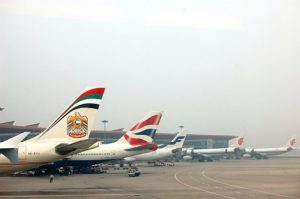 The global air cargo business should see a pause in profit decline in 2017 as the airline industry on the whole is forecast to make a net profit of nearly US$30 billion next year, according to the International Air Transport Association (IATA) in a new outlook.
The global air cargo business should see a pause in profit decline in 2017 as the airline industry on the whole is forecast to make a net profit of nearly US$30 billion next year, according to the International Air Transport Association (IATA) in a new outlook.
IATA said it is somewhat optimistic for the cargo business in the coming year, expecting a break in falling yields and a moderate uptick in demand of 3.5% that will see volumes reach a record high of 55.7 million tonnes in 2017, up from 53.9 million tonnes in 2016.
Cargo industry revenues for 2017 are expected to rise slightly to $49.4 billion, but IATA said this is still well below the $60 billion level of annual revenues experienced in 2010-2014.
“Trading conditions remain challenging,” it added of the cargo sector.
In the Asia-Pacific, improved cargo performance is expected to offset rising fuel prices for many of the region’s airlines. The expansion of new model airlines and progressive liberalization in the region is intensifying already strong competition. In addition profitability varies widely across the region.
Overall, Asia-Pacific carriers are expected to generate a net profit of $6.3 billion in 2017, down from $7.3 billion in 2016, for a net margin of 2.9%. On a per passenger basis, average profits are anticipated to be $4.44. Capacity offered by the region’s carriers is forecast to grow by 7.6%, ahead of a forecast growth in demand of 7.0%.
Meanwhile, the global airline industry in general is seen to post net earnings of $29.8 billion, a 4.1% net profit margin as total revenues are expected to amount to $736 billion.
“This will be the third consecutive year (and the third year in the industry’s history) in which airlines will make a return on invested capital (7.9%) which is above the weighted average cost of capital (6.9%),” said IATA.
For 2016, it revised slightly downward its outlook for airline industry profitability to $35.6 billion (from the June projection of $39.4 billion) owing to slower global GDP growth and rising costs. This will still be the highest absolute profit generated by the airline industry and the highest net profit margin (5.1%).
“2016 will be a record year for industry profitability. The expected net profit of $35.6 billion is slightly ahead of the $35.3 billion recorded in 2015, as is the 5.1% net profit margin (slightly ahead of the 4.9% recorded for 2015),” IATA said.
“Airlines continue to deliver strong results. This year we expect a record net profit of $35.6 billion. Even though conditions in 2017 will be more difficult with rising oil prices, we see the industry earning $29.8 billion. That’s a very soft landing and safely in profitable territory,” said Alexandre de Juniac, IATA’s director general and CEO.
He further stated that these three years are the best performance in the industry’s history, irrespective of the many uncertainties it faces. “Indeed, risks are abundant—political, economic and security among them. And controlling costs is still a constant battle in our hyper-competitive industry,” he added.
“We need to put this into perspective. Record profits for airlines means earning more than our cost of capital. For most other businesses that would be considered a normal level of return to investors. But three years of sustainable profits is a first for the airline industry. And after many years of hard work in restructuring and re-engineering the business the industry is also more resilient. We should also recognize that profits are not evenly spread with the strongest performance concentrated in North America,” said de Juniac.
2017 is expected to be the eighth year in a row of aggregate airline profitability, illustrating the resilience to shocks that have been built into the industry structure. On average, airlines will retain $7.54 for every passenger carried.
The negative impact of a lower load factor is expected to be offset somewhat by a strengthening of global economic growth. World GDP is projected to expand by 2.5% in 2017, up from 2.2% in 2016. Along with structural changes in the industry, this is expected to help stabilize yields for both the cargo and passenger businesses.
“This is a welcome development as yields (calculated in dollar terms) have fallen each year since 2012,” said IATA.
Photo: B747131





